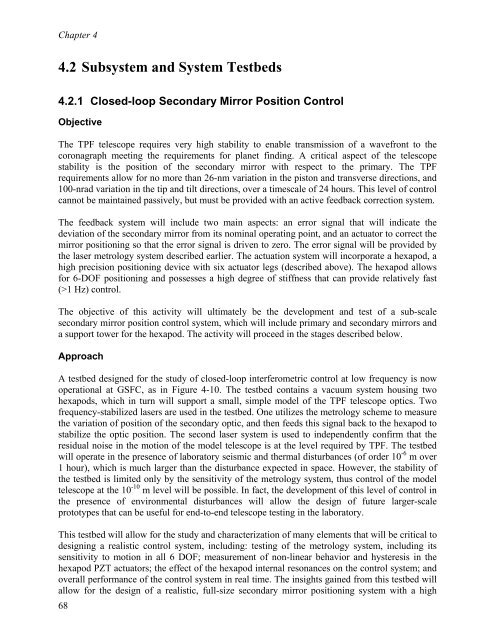TPF-C Technology Plan - Exoplanet Exploration Program - NASA
TPF-C Technology Plan - Exoplanet Exploration Program - NASA
TPF-C Technology Plan - Exoplanet Exploration Program - NASA
You also want an ePaper? Increase the reach of your titles
YUMPU automatically turns print PDFs into web optimized ePapers that Google loves.
Chapter 4<br />
4.2 Subsystem and System Testbeds<br />
4.2.1 Closed-loop Secondary Mirror Position Control<br />
Objective<br />
The <strong>TPF</strong> telescope requires very high stability to enable transmission of a wavefront to the<br />
coronagraph meeting the requirements for planet finding. A critical aspect of the telescope<br />
stability is the position of the secondary mirror with respect to the primary. The <strong>TPF</strong><br />
requirements allow for no more than 26-nm variation in the piston and transverse directions, and<br />
100-nrad variation in the tip and tilt directions, over a timescale of 24 hours. This level of control<br />
cannot be maintained passively, but must be provided with an active feedback correction system.<br />
The feedback system will include two main aspects: an error signal that will indicate the<br />
deviation of the secondary mirror from its nominal operating point, and an actuator to correct the<br />
mirror positioning so that the error signal is driven to zero. The error signal will be provided by<br />
the laser metrology system described earlier. The actuation system will incorporate a hexapod, a<br />
high precision positioning device with six actuator legs (described above). The hexapod allows<br />
for 6-DOF positioning and possesses a high degree of stiffness that can provide relatively fast<br />
(>1 Hz) control.<br />
The objective of this activity will ultimately be the development and test of a sub-scale<br />
secondary mirror position control system, which will include primary and secondary mirrors and<br />
a support tower for the hexapod. The activity will proceed in the stages described below.<br />
Approach<br />
A testbed designed for the study of closed-loop interferometric control at low frequency is now<br />
operational at GSFC, as in Figure 4-10. The testbed contains a vacuum system housing two<br />
hexapods, which in turn will support a small, simple model of the <strong>TPF</strong> telescope optics. Two<br />
frequency-stabilized lasers are used in the testbed. One utilizes the metrology scheme to measure<br />
the variation of position of the secondary optic, and then feeds this signal back to the hexapod to<br />
stabilize the optic position. The second laser system is used to independently confirm that the<br />
residual noise in the motion of the model telescope is at the level required by <strong>TPF</strong>. The testbed<br />
will operate in the presence of laboratory seismic and thermal disturbances (of order 10 -6 m over<br />
1 hour), which is much larger than the disturbance expected in space. However, the stability of<br />
the testbed is limited only by the sensitivity of the metrology system, thus control of the model<br />
telescope at the 10 -10 m level will be possible. In fact, the development of this level of control in<br />
the presence of environmental disturbances will allow the design of future larger-scale<br />
prototypes that can be useful for end-to-end telescope testing in the laboratory.<br />
This testbed will allow for the study and characterization of many elements that will be critical to<br />
designing a realistic control system, including: testing of the metrology system, including its<br />
sensitivity to motion in all 6 DOF; measurement of non-linear behavior and hysteresis in the<br />
hexapod PZT actuators; the effect of the hexapod internal resonances on the control system; and<br />
overall performance of the control system in real time. The insights gained from this testbed will<br />
allow for the design of a realistic, full-size secondary mirror positioning system with a high<br />
68
















